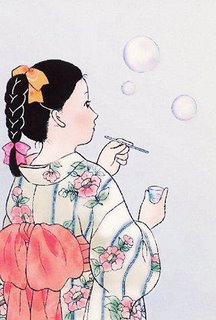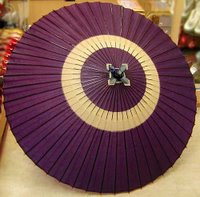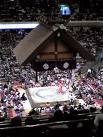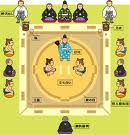:::::::::::::::::::::::::::::::::::::::::::::::::::::::::::::::::::::::::::::::::::::::::::::::::::::
Sponge gourd, loofah, luffa (hechima)
***** Location: Japan, other areas
***** Season: Late Autumn
***** Category: Plant
*****************************
Explanation
Sponge gourd, hechima, ito-uri 糸瓜, 蛮瓜,布瓜
long gourd, naga-uri, naga uri 長瓜
Luffa aegyptiaca
The translation of "snake gourd" often found in haiku is problematic. Snake gourd is another plant, see below.
There are many other types of gourds in Japan. Most of them are kigo.
Check them out here :
. Hyootan and Fukube ... Gourds and calabash
. Melons and watermelons (uri, suika)
:::::::::::::::::::::::::::::::::::::::::::::::::::::::::::::::::::::::::::::::::::::::::::::::::::::
Other Autumn kigo with the Sponge gourd
Shiki's (Death) Anniversary / Shiki's Memorial Day, Shiki-ki 子規忌
September 19, in honor of the famous haiku poet 正岡子規 Masaoka Shiki (1867-1902)
Sponge-gourd Anniversary, hechima-ki 糸瓜忌 へちまき
This naming stems from the sponge-gourd plant (hechima), used as medicine against phlegm for tuberculosis. He used this word in many of his haiku.
xxxxxxxxxxxxxxxxxxxxxxxxxxxxx
taking water from the sponge gourd,
hechima no mizu toru 糸瓜の水取る
..... hechima hiku 糸瓜引く
water of the sponge gourd, hechima no mizu 糸瓜の水
This liquid is used as medicine or in cosmetics. It is said to be most powerful when collected after the 15th of August (lunar calnedar) on the night of the full moon.
The vines are cut about 30 cm above the ground and the liquid taken from there. There is about one liter coming out in one day and night.
:::::::::::::::::::::::::::::::::::::::::::::::::::::::::::::::::::::::::::::::::::::::::::::::::::::
HECHIMA kigo for summer
seedlings of the sponge gourd, hechima nae 糸瓜苗
sowing sponge gourds, hechima maku 糸瓜蒔く
flower of the sponge gourd, hechima no hana 糸瓜の花
Click HERE to see the yellow flowers
xxxxxxxxxxxxxxxxxxxxxxxxxxxxx

In Japanese, the name of HE CHI MA is a play of sounds with the IROHA alphabet. For the advanced reader of Japanese, here is the reason:
、「糸瓜(いとうり)」の「と」は、
”いろはにほへとちりぬる・・・”の
「へ」と「ち」の間にある ことから、
”「へ」と「ち」の間” →”「へ」「ち」間”→ へちま
http://www.hana300.com/hechim.html
xxxxxxxxxxxxxxxxxxxxxxxxxxxxx
Luffa (Luffa aegyptica Mill syn. L. cylindrica),
or Loofah or vegetable sponge,
is a member of the Cucurbitaceae family. Luffa is closely related to and has similar cultural requirements as the cucumber. It is an annual climbing vine, which produces a fruit containing a fibrous vascular system. When separated from the skin, flesh and seeds, the fiber network can be used as a bathroom sponge.
Luffa can also be used as packing material, for making crafts, and as filters. Used as a bath sponge it produces a mild glow on the skin. The blood circulation the sponge induces on the skin has been credited as a relief for rheumatic and arthritic sufferers. The versatility of the luffa goes beyond producing sponges. The young fruit, when small, (around 6 inches) are delicious used in soup or stew. They can also be cooked like summer squash. Older fruit have been reported to develop purgative chemicals.
Because luffa has a compact network of close fibers, its resiliency makes it useful for many products like filters, slipper soles, baskets. Small pieces of luffa sponge are good for scraping vegetables like carrots without having to remove the valuable nutrients by peeling them. You can also wash dishes, scrub your tub, etc. with luffa. When they become soiled throw them in the washer! Luffa is environmentally safe, biodegradable and a renewable resource.
Read more facts about the luffa plant !
Click HERE to see more photos of this plant and its blossoms.
*****************************
Worldwide use
Names of this plant in various languages
ENGLISH : Loofah, Smooth loofah, Rag gourd, Vegetable-sponge, Sponge gourd, Dishrag gourd, Dish-cloth gourd, Rag gourd
HINDI : Mozhuku peerkankai, Jhinga, Dhundal, Turai, Meethi torai.
ITALIAN : Luffa, Luffa d'Egitto, Petola, Spugna vegetale.
SPANISH : Lufa, Esponja vegetal, Pepino para paste (El Salvador, Guatemala).
Copyright © 1997 - 2000 The University of Melbourne.
Maintained by: Michel H. Porcher
MULTILINGUAL MULTISCRIPT PLANT NAME DATABASE
*****************************
Things found on the way
TWENTIETH CENTURY JAPANESE PHILOSOPHICAL HAIKU:
Masaoka SHIKI
I define a philosophical haiku as a haiku which contains either explicitly or implicitly, a universal abstract proposition which is a statement of a philosophy. In my view, philosophical haiku are the superior type.
Read this essay by Hugh Bygott
*****************************
HAIKU
堂守の植ゑわすれたる糸瓜かな
doomori no ue-wasuretaru hechima kana
the temple warden
forgot to plant this
sponge gourd . . .
. Yosa Buson 与謝蕪村 in Edo .
::::::::::::::::::::::::::::::::::::::::::::::::::::::::::::::::::::::::::::::::::::::::::::::::::
- - - - - Masaoka Shiki - - - - -
糸瓜咲いて痰のつまりし仏かな
hechima saite tan no tsumarishi hotoke kana
Masaoka Shiki
The snake gourds are blooming:
here, choked with phlegm, lies a Buddha.
Tr. Hugh Bygott
Read the discussion about translating HOTOKE and HECHIMA
sponge gourds in bloom -
choked with phlegm,
this dead body
(Tr. Gabi Greve)
... ... ...
The loofah blooms and
I, full of phlegm,
become a Buddha.
Tr. Hoffmann : Japanese Death Poems
our loofah is blooming
here's a dead man
totally clogged with phlegm
Tr. Eiko Yachimoto
Quoted from the WHR
Susumu Takiguchi. Quoted from the WHR
xxxxxxxxxxxxxxxxxxxxxxxxxxxxx
More translated versions of this haiku, quoted from here.
A snake-gourd is blooming;
Clogged with phlegm,
A dying man.
Tr. Blyth
While sponge-gourd was in flower,
through too much phlegm
a Buddha kana
Tr. Harold J. Isaacson
the gourd flowers bloom,
but look--here lies
a phlegm-stuffed Buddha!
Tr. Beichman
The loofah blooms and
I, stuffed with phlegm,
become a Buddha.
Tr. Yoel Hoffman
snake gourd has flowered
choked up with phlegm
ah, Buddha!
Tr. Takiguchi
xxxxxxxxxxxxxxxxxxxxxxxxxxxxx
Here are what some commentators have written about this haiku:
Blyth:
"Just at this time, the 19th of September, 1902, a snake-gourd was in bloom. The juice of this plant is used for stopping the formation of phlegm, and this is the painful relation between him and the flowers. The last line is literally 'a Buddha,' which means 'soon to become a Buddha,' that is, a dead man."
Beichman:
"Here, the poet is no longer characterized as a sick man but as a dead man, and the separation between himself and the world has become complete and final. ...
"The juice of the gourd, gathered from the plant before it bloomed, was used to relieve coughing such as Shiki's. However, as his condition became past remedy, the juice had become useless and the flowers allowed to come into bloom. The blooming of the flowers, lovely in itself, has a sinister meaning, for it signifies the hopelessness of Shiki's condition, implies his death. Living flowers mean a dying Shiki -- again two opposites, held at one in the mind."
Issacson:
"As the Japanese politely speak of one newly departed as a Buddha (implying that his attainments must have enabled him to get free of the six realms of existence and enter the Buddha realm), the last line-- 'a Buddha kana'-- is a droll way of saying: 'I died.' The larger joke is in the way the haiku burlesques statements found in Buddhist biographies, that while lotuses were in flower some person dying
obtained birth in the Amida Paradise, Sukhavati."
:::::::::::::::::::::::::::::::::::::::::::::::::::::::::::::::::::::::::::::::::::::::::::::::::::::
From a translation project of the World Haiku Review
ototoi no hechima no mizu mo torazariki
Masaoka Shiki, 18/09/1902
since the day
before yesterday, not even gourd water
has been collected
(Version by Sususmu Takiguchi) (1)
Read more translations here:
http://www.worldhaikureview.org/1-3/shikitr5_8_01.shtml
the snake gourd sap..from two days back
.. .. .. .. .. is also left..ungathered
Shiki
http://www.villarana.freeserve.co.uk/zipschool/haiku%20translation%20two.htm
へちまとは 糸瓜のやうな物ならん
hechima to wa hechima no yoo na mono naran
the sponge gourd is
nothing more than a sponge gourd
I guess
source : Tr. Shiki Museum Volunteers
. WKD - Masaoka Shiki 正岡子規 .
:::::::::::::::::::::::::::::::::::::::::::::::::::::::::::::::::::::::::::::::::::::::::::::::::::::::::::::::::
Gabi Greve about the use of HOTOKE in Japanese
Any deceased person or dead body is referred to as HOTOKE 仏, but that does not carry the strong implication of BUDDHA, rather what it is, a deceased; dead body shitai 死体 is not used in colloquial language. Shisha 死者 is another word for a dead person in the news or legal proceedures.
Let me tell you a story.
Once I was called deep inside our woods to inspect a suicide, a farmer dead in his car. He had put a hose from the gas exhaust to the front room and choked ... (I am a specialist of legal medicine, so I know what I am doing in this case ..)
We wanted to make sure it was not murder, so here comes Gabi san and gives instructions to the Japanese local policeman (he had only seen two dead bodies (hotoke) in his whole career ..) and checks it all out, all the time talking about the HOTOKE SAN in his car.
We were just talking about the dead body, die Leiche, believe me, not about the BUDDHA.
It would never have occured to me to translate our conversation of this day as :
Look, the buddha took his shoes off before entering his car. See how the buddha was spitting slime in his last minutes? What shall we say to the wife of the buddha when we have to tell her? (the poor local policeman had never have to do this duty before ...)
and so on, just to show you that the translation of HOTOKE has its problems when it comes to a dead body in a real life situation.
Shiki seems not to have lost his humor, even in the last minute. Talking about himself as already dead !
Just a few weeks ago, in the NHK Haiku program, the sensei talked about this haiku in connection with examples for HUMOUR in haiku !
June 2006
:::::::::::::::::::::::::::::::::::::::::::::::::::::::::::::::::::::::::::::::::::::::::::::::::::::::::::::::::

Haiga by Nakamura Sakuo
へちまづる切って支舞ば他人哉
hechima-zuru kitte shimaeba tanin kana
after cutting
the snake gourd vine...
strangers
歌書や梶のかはりに糸瓜の葉
uta kaku ya kaji no kawari ni hechima no ha
writing the poem
on the mulberry substitute...
leaf of a gourd
世の中は糸瓜の皮ぞみんな露
yo no naka wa hechima no kawa zo minna tsuyu
in this world
are snake gourds
on each one, dewdrops
Issa, Tr. David Lanoue
*****************************
Related words

Kawanabe Gyosui (1831-1889)
***** Snake Gourd, karasu-uri 烏瓜
..... karasuuri, karasu uri 玉瓜(からすうり)
kigo for late autumn
Trichosanthes cucumeroides
. . . CLICK here for Photos !
Sometimes the name Snake Gourd is used as a translation for HECHIMA, but that is wrong.
玉章 たまずさ Tamazusa is another name of this plant.
The striking little red fruit makes this a kigo for autumn.
In Japanese, the word means a gourd for the crows, since they come to eat these fruit in autumn.
Sometimes the name Snake Gourd is used as a translation for HECHIMA 糸瓜.
The plant grows like grapewine in other plants. The flowers can be seen in summer, they look almost as delicate as a lace.
When the leaves are dried off, the red fruit hangs in the tree and is a delicious treat for the animals, hence the Japanese naming: Crow’s Gourd.
The vine hangs in the trees and bushes like a snake, therefore the naming. The flowers open in the evening and look pretty like a lace. The seeds have a special form like a lucky mallet and if you keep one in your purse, you will become a rich man! (or so they say!)
Ki-Karasu-Uri 黄烏瓜 The Yellow Snake GourdThe fruit has a yellow-orange color. Trichosanthes kirilowii
. . . CLICK here for Photos !
yamasato no hibi fukamareba karasu-uri
in the mountain village
days get more intense -
snake gourds
With winter coming, there is a lot to prepare and the days are almost too
short for all the work to be done.
Gabi Greve, 2004
烏瓜夕日たぐりて炎えにけり
Snake gourds
In the evening sun
They are glowing
Oota Midori
.................................................................................
kigo for late summer
karasuuri no hana 烏瓜の花 flower of the snake gourd
They look almost like a lace when they open in the evening, but they close in the morning.

:::::::::::::::::::::::::::::::::::::::::::::::::::::::::::::::::::::::::::::::::::::::::::::::::::::
***** Dead body, deceased person, hotoke 仏
Non-seasonal topic for haiku.
***** Melons and Gourds
hyootan, fukube 瓢箪 gourd, calabash
[ . BACK to WORLDKIGO . TOP . ]
:::::::::::::::::::::::::::::::::::::::::::::::::::::::::::::::::::::::::::::::::::::::::::::::::::::

































